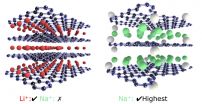(Press-News.org) Struggling to balance on one leg for 20 seconds or longer was linked to an increased risk for small blood vessel damage in the brain and reduced cognitive function in otherwise healthy people with no clinical symptoms, according to new research in the American Heart Association's journal Stroke.
"Our study found that the ability to balance on one leg is an important test for brain health," said Yasuharu Tabara, Ph.D., lead study author and associate professor at the Center for Genomic Medicine at Kyoto University Graduate School of Medicine in Kyoto, Japan. "Individuals showing poor balance on one leg should receive increased attention, as this may indicate an increased risk for brain disease and cognitive decline."
The study consisted of 841 women and 546 men, average age of 67. To measure one-leg standing time, participants stood with their eyes open and raised one leg. The maximum time for keeping the leg raised was 60 seconds. Participants performed this examination twice and the better of the two times was used in the study analysis. Cerebral small vessel disease was evaluated using brain magnetic resonance imaging.
Researchers found that the inability to balance on one leg for longer than 20 seconds was associated with cerebral small vessel disease, namely small infarctions without symptoms such as lacunar infarction and microbleeds. They noted that:
34.5 percent of those with more than two lacunar infarction lesions had trouble balancing.
16 percent of those with one lacunar infarction lesion had trouble balancing.
30 percent of those with more than two microbleed lesions had trouble balancing.
15.3 percent one microbleed lesion had trouble balancing.
Overall, those with cerebral diseases were older, had high blood pressure and had thicker carotid arteries than those who did not have cerebral small vessel disease. However, after adjustment for these covariates, people with more microbleeds and lacunar infarctions in the brain had shorter one-legged standing times. Short one-legged standing times were also independently linked with lower cognitive scores.
Although previous studies have examined the connection between gait and physical abilities and the risk of stroke, this is among the first study to closely examine how long a person can stand on one leg as an indication of their overall brain health.
"One-leg standing time is a simple measure of postural instability and might be a consequence of the presence of brain abnormalities," said Tabara.
Small vessel disease occurs due to microangiopathy of arterioles in the brain, making these arteries less flexible, which can interfere with blood flow. Small vessel disease typically increases with age. Loss of motor coordination, including balance, as well as cognitive impairment has been suggested to represent subclinical brain damage. Tabara and colleagues also found a strong link between struggling to stand on one leg and increased age, with marked shorter one-leg standing time in patients age 60 and over.
Although the study did not assess participants' histories of falling or physical fitness issues, such as how fast they could walk or any gait abnormalities, Tabara said the one-leg standing test is an easy way to determine if there are early signs of being at risk for a stroke and cognitive impairment and whether these patients need additional evaluation.
INFORMATION:
Co-authors areYoko Okada, M.D., Ph.D.; Maya Ohara, M.D.; Eri Uetani, M.D., Ph.D.; Tomoko Kido, M.D., Ph.D.; Namiko Ochi, M.D., Ph.D.; Tokihisa Nagai, M.D., Ph.D.; Michiya Igase, M.D., Ph.D.; Tetsuro Miki, M.D., Ph.D.; Fumihiko Matsuda, Ph.D.; and Katsuhiko Kohara, M.D., Ph.D. Author disclosures and funding are on the manuscript.
Additional Resources:
Study photo of man balancing on one leg and brain illustration available on the right column of this release link
Slowing brain functions linked to increased risk of stroke, death
Protect Your Heart, Protect Your Brain
Keeping Your Balance After Stroke
Follow AHA/ASA news on Twitter @HeartNews.
For stroke science, follow the Stroke journal at @StrokeAHA_ASA
Statements and conclusions of study authors published in American Heart Association scientific journals are solely those of the study authors and do not necessarily reflect the association's policy or position. The association makes no representation or guarantee as to their accuracy or reliability. The association receives funding primarily from individuals; foundations and corporations (including pharmaceutical, device manufacturers and other companies) also make donations and fund specific association programs and events. The association has strict policies to prevent these relationships from influencing the science content. Revenues from pharmaceutical and device corporations are available at http://www.heart.org/corporatefunding.
For Media Inquiries: (214) 706-1173
Akeem Ranmal: (214) 706-1755; t-akeem.ranmal@heart.org
Julie Del Barto (broadcast): (214) 706-1330; julie.delbarto@heart.org
For Public Inquiries: (800)-AHA-USA1 (242-8721)
heart.org and strokeassociation.org
Life is why we fund scientific breakthroughs that save and improve lives.
WINSTON-SALEM, N.C. - Dec. 18, 2014 - State and local enforcement of federal immigration laws can have an adverse impact on the use of health care services by immigrant Hispanics, according to a North Carolina-based study by Wake Forest Baptist Medical Center researchers.
The study, published in the Dec. 18 issue of the American Journal of Public Health, analyzed both birth records and information collected in focus groups and individual interviews.
"Our findings suggest that immigration enforcement policies negatively affect the health of immigrant Hispanics, including ...
An investigation into factors related to disparities of depression in young adults has found that higher parental education - which has a protective effect for white youth - can also increase the risk of depression for black youth. The MassGeneral Hospital for Children (MGHfC) study published online in the Journal of Pediatrics also found that, among high-socioeconomic-status black youth, greater perceptions of being discriminated against cancelled out the protective effects of parental education.
"High socioeconomic status (SES) - particularly higher parent education ...
Before Charlotte the spider spelled the word "humble" in her web to describe Wilbur the pig, she told Templeton the rat that the word meant "not proud."
That's probably what most people say if you put them on the spot. But if you give them time to think about it deeply, like a new study just did, other themes emerge that have a lot to do with learning.
And these intellectual dimensions of humility describe the spider as well or better than the pig.
"Wilbur has many of the dimensions of humility in general: regard for others, not thinking too highly of himself - but ...
Auroras are the most visible manifestation of the sun's effect on Earth, but many aspects of these spectacular displays are still poorly understood. Thanks to the joint European Space Agency and NASA's Cluster mission combined with data from a past NASA mission called the Imager for Magnetopause-to-Aurora Global Exploration, or IMAGE, a particular type of very high-latitude aurora has now been explained.
Known as a theta aurora -- because seen from above it looks like the Greek letter theta, an oval with a line crossing through the center -- this type of aurora sometimes ...
ITHACA, N.Y. - To encode data, today's computer memory technology uses electric currents - a major limiting factor for reliability and shrinkability, and the source of significant power consumption. If data could instead be encoded without current - for example, by an electric field applied across an insulator - it would require much less energy, and make things like low-power, instant-on computing a ubiquitous reality.
A team at Cornell University led by postdoctoral associate John Heron, who works jointly with Darrell Schlom, professor of Industrial Chemistry in the ...
Scientists from WCS (Wildlife Conservation Society), the Universidad Austral de Chile, the Blue Whale Center, the American Museum of Natural History (AMNH), NOAA, and other organizations are examining molecular clues to answer a big question: how many types of blue whales exist in the waters of the southeastern Pacific?
The answer seems to be two distinct populations, according to a genetic study comparing the blue whales off the southern coast of Chile with those swimming in the waters of Antarctica and other nearby regions. One of the populations could be made up of ...
By 2050, a majority of U.S. coastal areas are likely to be threatened by 30 or more days of flooding each year due to dramatically accelerating impacts from sea level rise, according to a new NOAA study, published today in the American Geophysical Union's online peer-reviewed journal Earth's Future.
The findings appear in the paper From the Extreme to the Mean: Acceleration and Tipping Points for Coastal Inundation due to Sea Level Rise, and follows the earlier study, Sea Level Rise and Nuisance Flood Frequency Changes around the United States, by the report's co-author, ...
MANHATTAN, KANSAS -- A Kansas State University engineering team has discovered some of graphene oxide's important properties that can improve sodium- and lithium-ion flexible batteries.
Gurpreet Singh, assistant professor of mechanical and nuclear engineering, and Lamuel David, doctoral student in mechanical engineering, India, published their findings in the Journal of Physical Chemistry in the article "Reduced graphene oxide paper electrode: Opposing effect of thermal annealing on Li and Na cyclability."
Graphene oxide is an insulating and defective version of graphene ...
Many genetic mutations in visual pigments, spread over millions of years, were required for humans to evolve from a primitive mammal with a dim, shadowy view of the world into a greater ape able to see all the colors in a rainbow.
Now, after more than two decades of painstaking research, scientists have finished a detailed and complete picture of the evolution of human color vision. PLOS Genetics is publishing the final pieces of this picture: The process for how humans switched from ultraviolet (UV) vision to violet vision, or the ability to see blue light.
"We ...
Ibuprofen, a common over-the-counter drug used to relieve pain and fever, could hold the keys to a longer healthier life, according to a study by researchers at the Buck Institute for Research on Aging. Publishing in PLoS Genetics on December 18th, scientists showed that regular doses of ibuprofen extended the lifespan of yeast, worms and fruit flies.
"There is a lot to be excited about," said Brian Kennedy, PhD, CEO of the Buck Institute, who said treatments, given at doses comparable to those used in humans, extended lifespan an average of 15 percent in the model ...



